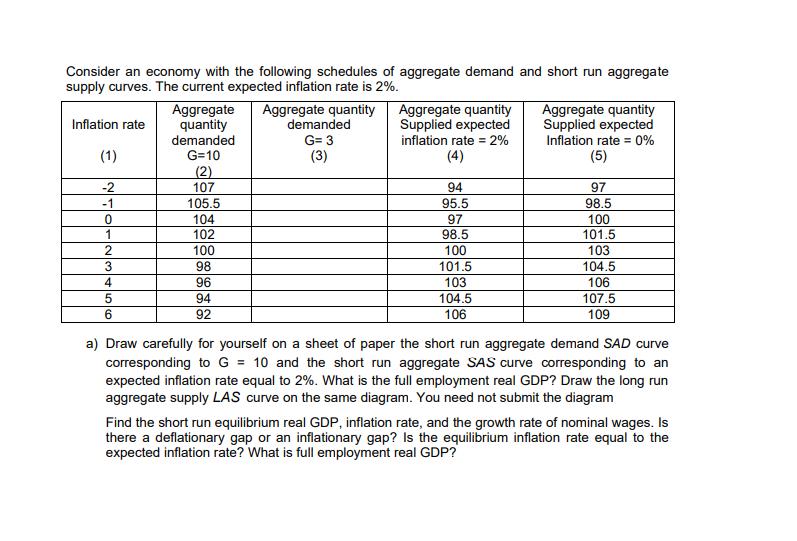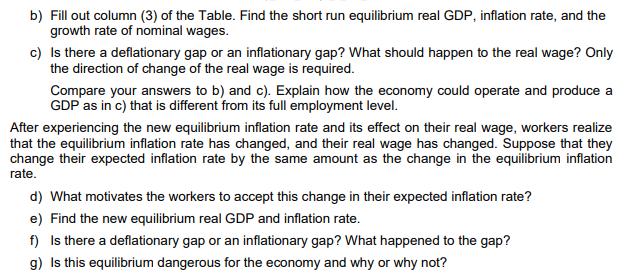Answered step by step
Verified Expert Solution
Question
1 Approved Answer
Consider an economy with the following schedules of aggregate demand and short run aggregate supply curves. The current expected inflation rate is 2%. Aggregate


Consider an economy with the following schedules of aggregate demand and short run aggregate supply curves. The current expected inflation rate is 2%. Aggregate quantity demanded G= 3 (3) Inflation rate (1) -2 -1 0 1 2 3 4 5 6 Aggregate quantity demanded G=10 (2) 107 105.5 104 102 100 98 96 94 92 Aggregate quantity Supplied expected inflation rate = 2% (4) 94 95.5 97 98.5 100 101.5 103 104.5 106 Aggregate quantity Supplied expected Inflation rate = 0% (5) 97 98.5 100 101.5 103 104.5 106 107.5 109 a) Draw carefully for yourself on a sheet of paper the short run aggregate demand SAD curve corresponding to G = 10 and the short run aggregate SAS curve corresponding to an expected inflation rate equal to 2%. What is the full employment real GDP? Draw the long run aggregate supply LAS curve on the same diagram. You need not submit the diagram Find the short run equilibrium real GDP, inflation rate, and the growth rate of nominal wages. Is there a deflationary gap or an inflationary gap? Is the equilibrium inflation rate equal to the expected inflation rate? What is full employment real GDP? b) Fill out column (3) of the Table. Find the short run equilibrium real GDP, inflation rate, and the growth rate of nominal wages. c) Is there a deflationary gap or an inflationary gap? What should happen to the real wage? Only the direction of change of the real wage is required. Compare your answers to b) and c). Explain how the economy could operate and produce a GDP as in c) that is different from its full employment level. After experiencing the new equilibrium inflation rate and its effect on their real wage, workers realize that the equilibrium inflation rate has changed, and their real wage has changed. Suppose that they change their expected inflation rate by the same amount as the change in the equilibrium inflation rate. d) What motivates the workers to accept this change in their expected inflation rate? e) Find the new equilibrium real GDP and inflation rate. f) Is there a deflationary gap or an inflationary gap? What happened to the gap? g) Is this equilibrium dangerous for the economy and why or why not?
Step by Step Solution
★★★★★
3.33 Rating (165 Votes )
There are 3 Steps involved in it
Step: 1

Get Instant Access to Expert-Tailored Solutions
See step-by-step solutions with expert insights and AI powered tools for academic success
Step: 2

Step: 3

Ace Your Homework with AI
Get the answers you need in no time with our AI-driven, step-by-step assistance
Get Started


